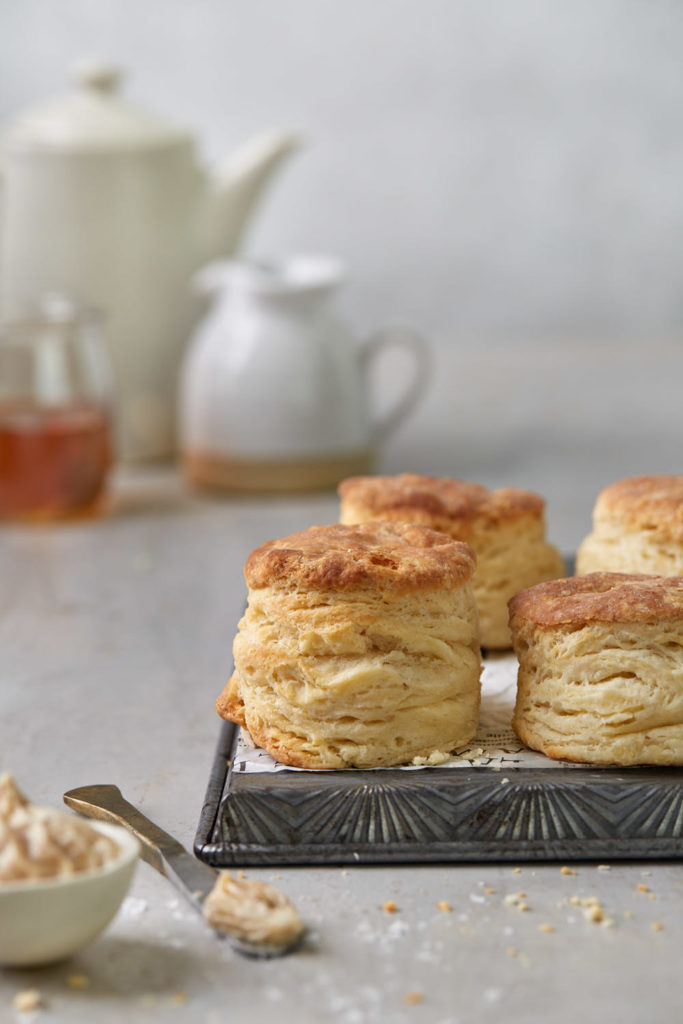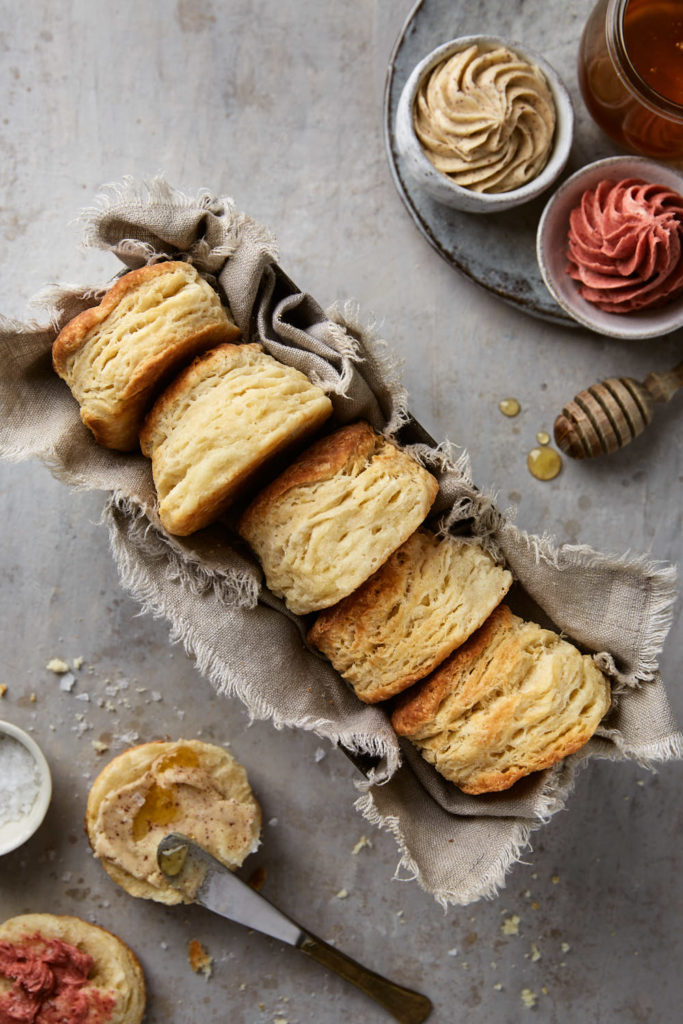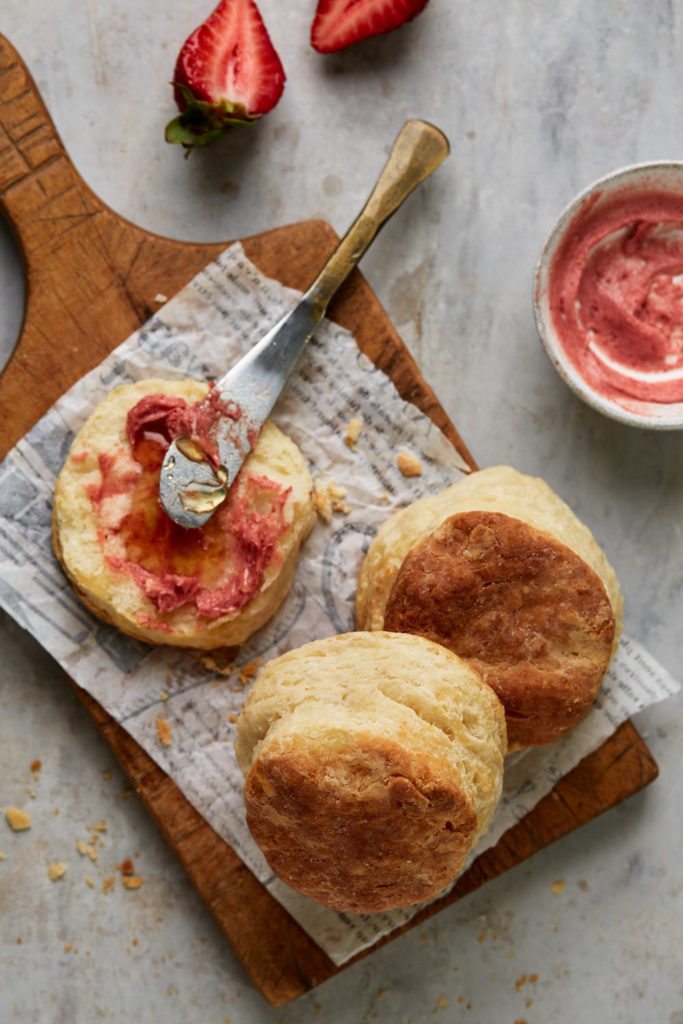
I did not grow up with the tradition of buttermilk biscuits. We were more of a party sandwiches and whipped Jello mold kind of a family. (My mom was fancy like that!)
I have been to Nashville and eaten some incredible buttermilk biscuits and wanted to learn to recreate them at home. In my quest to learn, I spent last week baking buttermilk biscuits every day. My husband was thrilled and I think I have succeeded. Just look at these babies. Lofty, light, fluffy and flaky AF. We froze the extra biscuits and discovered they are quite delicious toasted.

I learned a few things along the way and I’d love to share those lessons with you.
The type of flour you use makes a difference. All-purpose flour has a higher protein content than cake and pastry flour. More protein means more gluten, which gives the dough enough structure/body to create flaky layers and a nice crusty exterior. But using all-purpose flour exclusively led to a biscuit that was a bit tough. Cake and pastry flour, with its lower protein content, does not develop gluten as well as all-purpose flour. This results in light fluffy biscuits but those made exclusively with this flour did not rise as high or achieve the flaky layers I desired. The ideal was a 55%/45% (by weight) mix of all-purpose and cake and pastry flour.
Use both baking soda and baking powder. Baking soda has an alkaline base, which means it is not acidic. It needs acid to activate it and create carbon dioxide, which provides the leavening. Buttermilk plays the role of acid in these biscuits. It also adds a nice tangy flavour. Too much baking soda would completely neutralize that tangy flavour and leave behind unactivated baking soda which tastes metallic. Baking powder is made up of baking soda plus a dry acid. That additional acid will help give the biscuits their characteristic tang, plus provide extra leavening insurance.
The butter must be very cold. If you tend to have hot hands, I would suggest investing in a pastry blender. They are inexpensive and do a great job of working the butter into the flour. Make sure that you don’t totally work the butter into the flour. leave a few pea sized bits of butter. Butter is 20% water, so when those little knobs of butter hit the hot oven, they will melt and release steam, which creates pockets of air for maximum lift.
Don’t over knead the dough: You are not looking for a ball of dough that is as smooth as a baby’s bottom. After adding the buttermilk, the dough will look like a shaggy mess. That is correct. Just knead the dough 6-7 times until there is no dry flour visible. You will still see little knobs of butter in the dough.
Building layers is the key to flaky biscuits. Shape the dough into a rectangle, roughly 11×7 inches. I used a rolling pin to start and then used my bench scraper to help me straighten the edges. A ruler would also be an excellent tool for this. Next, fold the dough into thirds, as if you were folding a sheet of paper into thirds to fit into an envelope. Repeat this flattening and folding twice more and you have built in your layers.
Don’t twist the biscuit cutter. Press the cutter down into the dough and then lift it straight back up again. If you twist it, you seal off the edges of the dough, prohibiting the biscuits from rising evenly.
Snuggle. Place biscuits close together on baking sheet, almost touching. When they are in close proximity they provide support to each other and can grow up nice and tall.
Chill. Place unbaked biscuits in fridge for a 15 minute rest before baking. This gives the gluten time to relax, resulting in more tender biscuits and the butter can harden. If the butter is too soft, the biscuits will spread and slump more readily.
Here’s a video to show you how it all comes together.
Don’t skip making the whipped brown honey butter. I have included a recipe for how to make it. Once you brown the butter, chill in the fridge to solidify. Then whip it with a hand mixer and add a bit of honey and salt to taste. Leftover butter freezes perfectly. I also made some strawberry butter by whipping 125 grams unsalted butter (not browned butter) with 3 Tablespoons freeze dried strawberry powder, 2 teaspoons of honey and a pinch of salt.)


Sigh, As a Northerner married to a Southerner I have tried for several years to succeed at making biscuits ‘like my mother used to make’. YOU have succeeded in just one week!!
Aw thanks Michelle. You must try again with this recipe. Let me know!!